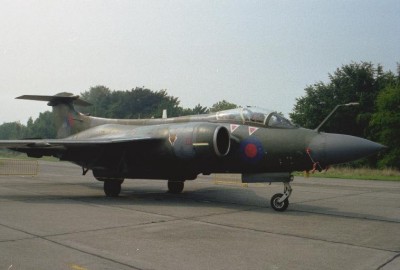|

Blackburn Buccaneer

St'Truiden AFB Belgium 1989 RAF Blackburn Buccaneer (Marcel van Leeuwen)
The Buccaneer, designed
to fulfil a Royal Navy requirement for a long-range carrier-based attack
aircraft, first entered service in July 1962. From its first operational
missions to its last in 1992, it remained one of the fastest low-level
aircraft in any service. This was due in part to its high-thrust engine
and small wings, the latter made possible by the use of Boundary-Layer
Control. BLC gave the wings more lift than would be otherwise possible by
channelling air over the wings and tail through full-span slits in the
surfaces.
The
first Buccaneer S.1s were replaced in 1965 with
Spey-engined S.2s, and soon after, the Royal Air
Force inherited all the Navy's Buccaneers when a political decision was
made to remove all fixed-wing carriers from Naval service. The RAF
re-designated some of the aircraft as S.2As and
later, after more modifications, as S.2Bs. A
small number of new production S.2Bs were also built, beginning in early
1970, and all earlier unmodified Buccs were updated and redesignated
S.2C and S.2D.
Meanwhile, the Buccaneer Mk 50 version had been
supplied to the South African Air Force (SAAF) in 1965, these fitted with
a supplementary twin-chamber rocket motor in the aft fuselage to
facilitate takeoffs from hot, high-altitude airfields. The Buccaneer first
saw combat in the 1970s and 1980s with the SAAF, but it was not until the
very end of the type's RAF service that the Buccaneer was able to prove
itself in the service of its "home country." In 1991, Buccaneers fought
very successfully in Iraq and Kuwait during Operation Desert Storm.
At
least three airworthy Buccaneers exist; all are actively flying with Mike
Beachy Head's impressive operation in South Africa. (See Links
below).
Nicknames:
Banana Bomber / 'Nana / Peeled
Banana; Brick; Bucc; Easy Rider; Dirt Eater
Specifications (S.2B):
Engines: Two 11,255-pound thrust
Rolls-Royce RB.168 Spey Mk 101 turbofans
Weight: Empty 30,000 lbs., Max Takeoff 62,000 lbs.
Wing Span: 44ft. 0in.
Length: 63ft. 5in.
Height: 16ft. 3in.
Performance:
Maximum Speed at 200 ft AGL: 646 mph
Ceiling: Over 40,000 ft.
Range: 2,300 miles with weapons
Armament:
Four 1,000-pound bombs, fuel tank or reconnaissance pack on
inside of rotary bomb door;
Up to 12,000 pounds of bombs on four underwing hardpoints
Number Built:
~170
Number Still Airworthy:
Three |
